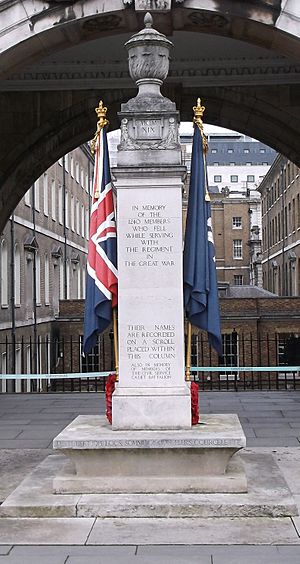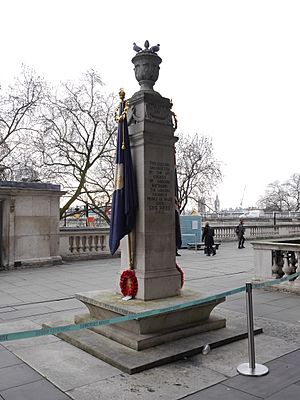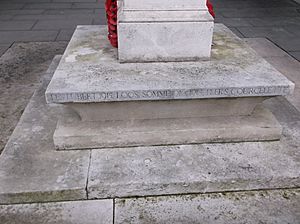Civil Service Rifles War Memorial facts for kids
Quick facts for kids Civil Service Rifles War Memorial |
|
|---|---|
| United Kingdom | |
 |
|
| For members of the Prince of Wales' Own Civil Service Rifles killed in the First World War | |
| Unveiled | 27 January 1924 |
| Location | 51°30′37″N 0°07′03″W / 51.51040°N 0.11755°W Riverside terrace, Somerset House, London
|
| Designed by | Sir Edwin Lutyens |
|
Listed Building – Grade II
|
|
| Official name | The Civil Service Rifles War Memorial |
| Designated | 1 December 1987 |
| Reference no. | 1237096 |
The Civil Service Rifles War Memorial is a special monument in central London, England. It remembers soldiers from World War I. You can find it on the riverside terrace at Somerset House. Famous architect Sir Edwin Lutyens designed it. It was first shown in 1924. This memorial honors 1,240 brave soldiers from the Prince of Wales' Own Civil Service Rifles regiment. They sadly died during the First World War.
These soldiers were reserve soldiers. Many of them worked for the British Civil Service. At that time, many civil servants worked at Somerset House.
After the war, the Civil Service Rifles regiment was disbanded. It joined with another group, the Queen's Westminster Rifles. But former members created an "Old Comrades Association." They wanted to keep the regiment's history alive. This group started raising money for a memorial in 1920. The Prince of Wales officially opened the memorial on January 27, 1924.
The memorial looks like a tall, rectangular column. On top, there's a sculpture of an urn. Stone flags hang on either side. One is the Union Flag. The other is the regimental flag. The base of the column lists the regiment's important battles. An inscription on the column says that a list of the fallen soldiers' names is inside.
The memorial first stood in the main courtyard of Somerset House. This courtyard was where the Civil Service Rifles used to practice. Later, the government offices moved out of Somerset House. The building was used for new purposes. So, the memorial was moved to the riverside terrace in the late 1990s. Former members of the regiment continued to attend Remembrance Sunday ceremonies. They did this until at least the late 1980s. By then, many were in their nineties. The last known surviving member attended a special ceremony in 2002.
The memorial became a "grade II" listed building in 1987. This means it's an important historical structure. In 2015, its status was upgraded to "grade II*". This happened as part of a national effort to recognize Lutyens' war memorials.
Contents
Why Was This Memorial Built?
After the First World War, many people had died. Thousands of war memorials were built across Britain. Sir Edwin Lutyens was one of the most important designers of these memorials. People called him "the leading English architect of his generation."
Lutyens was known for designing large country homes for rich people. But the war deeply affected him. After the war, he spent much of his time honoring those who died. He became famous for designing The Cenotaph in London. This became Britain's national war memorial. He also worked for the Commonwealth War Graves Commission. This led to many requests for war memorials. He designed them across Britain and its empire.
Lutyens designed memorials for towns and cities. He also designed them for private companies and army groups. The Civil Service Rifles memorial was one of these. These memorials were often easier to build. They usually had good locations and enough money.
The Civil Service Rifles Regiment

The Civil Service Rifles had a long name: "15th (County of London) Battalion, the London Regiment (the Prince of Wales' Own Civil Service Rifles)." It was a unit in the Territorial Force. This was a part-time reserve part of the British Army.
The soldiers in this regiment came from the Civil Service. This is the group of people who work for the British government. Many civil servants worked at Somerset House. It was an important government building. The regiment used its courtyard as a place to practice.
The soldiers were at their yearly training camp in Salisbury Plain. This was on August 4, 1914. On that day, Britain declared war on Germany. The battalion was quickly called to duty. They trained in Hertfordshire. Then, in 1915, they were sent to the Western Front in France.
They arrived in France on March 18. They fought in major battles. These included the Battle of Loos in 1915. They also fought in the Battle of the Somme in 1916. In 1917, they were at the Battle of Passchendaele. They also fought during the Hundred Days Offensive in 1918. A second battalion was formed. It served in France, then Salonika and Palestine.
Both battalions were disbanded after the war. About 7,000 soldiers served overseas with the regiment. Of these, 1,240 officers and men died.
How the Memorial Was Commissioned
After the war, soldiers who had left the army formed an "Old Comrades Association." They started talking about how to remember their fallen comrades. The association created a War Memorial Committee. Major W. H. Kirby led this committee. They started asking for donations to build a memorial. They needed £750. Most of the money came from former members. They also sold a book about the regiment's history.
The committee first asked architect Herbert Baker to design the memorial. His design was approved in June 1919. Baker suggested putting the memorial in the north part of the Somerset House courtyard. It would be behind the statue of King George III.
Later, the committee chose Sir Edwin Lutyens instead of Baker. Lutyens strongly believed the memorial should be in the center of the courtyard. The Office of Works disagreed. They worried about how a memorial in such a central spot would affect the old 18th-century buildings. But Lutyens looked at the original plans for Somerset House. He argued that the architect, Sir William Chambers, had planned for something in the center. The Office of Works finally agreed.
What the Memorial Looks Like
The memorial is a single, rectangular column. It is made of Portland stone. This stone is a light-colored limestone. The column has classic decorations. It stands about 4.9 meters (16 feet) tall. At the very top, there's a flat cornice. On this, a plinth holds a sculpture of an urn. The plinth is decorated with laurel swags.
The column stands on a square base. This base rests on two square steps. Painted stone flags hang from each side of the column. The regiment's colors are on the east side (right, when looking from the front). The Union Flag is on the west side (left). These flags were first made of copper. Later, they were replaced with carved stone.
No names are listed on the memorial itself. But a scroll with the names of the soldiers who died was placed inside the column. Lutyens wanted his design to fit well with the stone buildings of Somerset House. However, the colorful flags stood out. Painted stone flags were a common idea in Lutyens' war memorial designs. He first suggested them for the Cenotaph. There, fabric flags were used instead. But they appear on several of his other designs.
Inscriptions and Battle Honors
On the front (north) side, the dedication reads: THIS COLUMN WAS ERECTED BY THE 15TH COUNTY OF LONDON BATTALION THE LONDON REGIMENT PRINCE OF WALES OWN CIVIL SERVICE RIFLES. The south side says: IN MEMORY OF THE 1240 MEMBERS WHO FELL WHILE SERVING WITH THE REGIMENT IN THE GREAT WAR THEIR NAMES ARE RECORDED ON A SCROLL PLACED WITHIN THIS COLUMN / ALSO IN MEMORY OF MEMBERS OF THE CIVIL SERVICE CADET BATTALION.
The war's start and end dates are written in Roman numerals below the urn. "MCMXIV" (1914) is on the north side. "MCMXIX" (1919) is on the south.
The regiment's battle honours are carved around the base. These are names of important battles they fought in:
- South side: Festubert, Loos, Somme, and Flers–Courcelette.
- West side: Doiran, Lys/Kemmel, Gaza, Nebi Samwil, and Jerusalem.
- North side: St Quentin, Albert, Ancre, Bapaume, and Selle.
- East side: Transloy, Messines, Ypres, and Cambrai.
History of the Memorial

The memorial was built at Nine Elms Stone Masonry Works in Battersea, south London. Edward, Prince of Wales, who was the regiment's honorary colonel, officially opened it. He wore the uniform of a Welsh Guards colonel. The Reverend E. H. Beattie, the 1st Battalion's chaplain, dedicated it. This ceremony happened on January 27, 1924.
The regimental band played music. The choir from St Clement Danes church also sang. The "Last Post" and "Reveille" were played. The crowd sang the national anthem, God Save the King. Many important people were there. These included the Suffragan Bishop of Willesden, William Perrin. Several senior army officers, former regiment members, and their families also attended.
After the war, the Civil Service Rifles became smaller. It joined with the Queen's Westminster Rifles. They formed the 16th Battalion, the London Regiment. But the veterans wanted to keep the old regiment's traditions alive. Members of the Civil Service companies formed a guard of honour at the ceremony. Before the memorial was unveiled, the government agreed to take care of its maintenance.
In 1926, lines about the cadet battalion were added to the inscription. Major Kirby had asked for permission to do this. The memorial was damaged by German bombing during the Second World War. It was repaired and restored in the 1950s.
As former members passed away, a tradition began. A widow would lay the first wreath at the yearly Remembrance Sunday ceremony. This is the Sunday closest to November 11. Surviving members continued to meet at the memorial. They did this until the late 1980s. By then, the attendees were in their nineties.
Moving the Memorial
By the early 1980s, fewer civil servants worked at Somerset House. The government started renting parts of the building for other uses. The issue was brought up in the House of Lords. Lord Houghton of Sowerby, a former regiment member, asked about the memorial's future. Lord Skelmersdale replied for the government. He said the regiment had a great record. He felt it was right for the memorial to be in the courtyard. He promised it would not be moved.
However, the memorial was moved in the late 1990s. The courtyard was changed to create a public exhibition space. The memorial was restored. Its flags were repainted. Then, it was put in a new spot. This was in front of the Navy Treasurer's door. It's on the Embankment side of Somerset House. This is on a terrace next to the River Thames.
The Royal Green Jackets organized a new dedication ceremony. This group is the successor to the Civil Service Rifles. The ceremony took place on July 25, 2002. Richard Chartres, the Bishop of London, led it. The head of the Inland Revenue laid a wreath. The Inland Revenue was based at Somerset House. Its officials were among the first members of the Civil Service Rifles. Relatives of former members were there. Walter Humphrys, the last known surviving veteran from the First World War, also attended.
The memorial became a "grade II" listed building in 1987. This protects it from being destroyed or changed. About 92% of listed buildings are grade II. This means they are of "special interest." In November 2015, its status was upgraded to "grade II*." This is for "particularly important buildings." Only about 5.5% of listed buildings are grade II*. This happened as part of remembering the First World War's 100th anniversary. Historic England recognized Lutyens' war memorials as a national collection.


